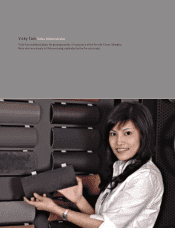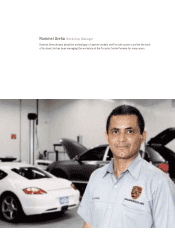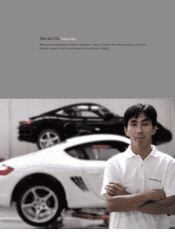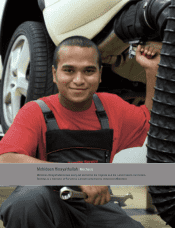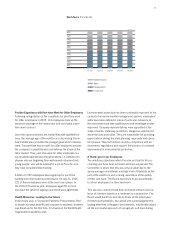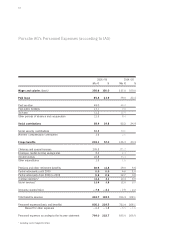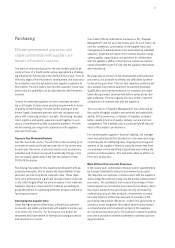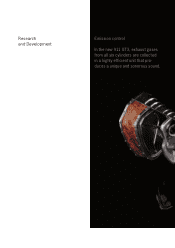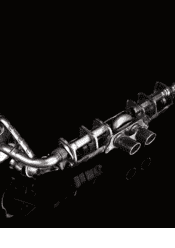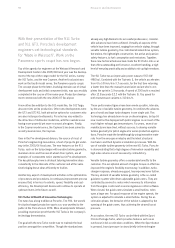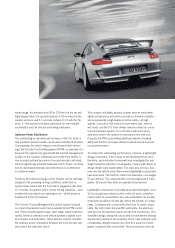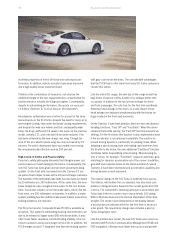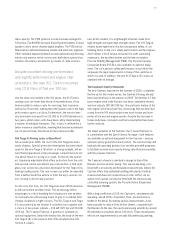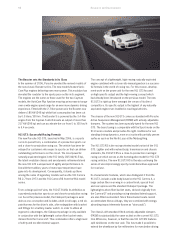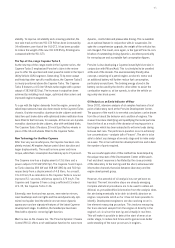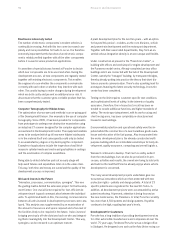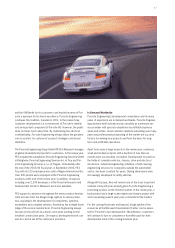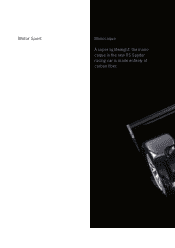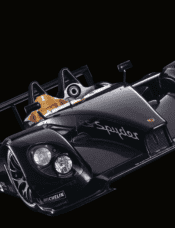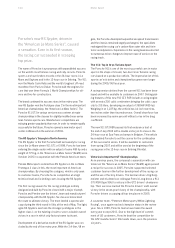Porsche 2005 Annual Report Download - page 92
Download and view the complete annual report
Please find page 92 of the 2005 Porsche annual report below. You can navigate through the pages in the report by either clicking on the pages listed below, or by using the keyword search tool below to find specific information within the annual report.90 Research and Development
With their presentation of the 911 Turbo
and 911 GT3, Porsche’s development
engineers set technological standards
for “Made in Weissach”. Work on the
Panamera sports coupé has now begun.
Top of the agenda for engineers at the Weissach Research and
Development Center in the 2005/06 fiscal year was the develop-
ment of the top-of-the-range model for the 911 series, namely
the 911 Turbo, and the new Cayenne. Another focal point was
work on the fourth model series, the Panamera sports coupé.
The concept phase for the latter, involving intensive use of virtual
development tools and initial component trials, was successfully
completed in the course of the review year. Production develop-
ment commenced with the new 2006/07 fiscal year.
A new attractive addition to the 911 model line, the 911 Targa,
also went into series production. Other new developments were
the GT3 and GT3 RS, both attractive options for customers who
are also motorsport enthusiasts. Porsche has also added to
the attraction of its Boxster model line, with the roadsters now
having more powerful yet more economical engines. Finally,
in the Cayman model series, the Cayman S has been joined by
an entry-level version, the Cayman.
Over in the Pre-development division, the source of most of
Porsche’s engineering innovations, a host of projects got under-
way in the 2005/06 fiscal year. The new features on the 911
Turbo, such as the turbocharger with variable turbine geometry,
aluminum doors and the new all-wheel drive system, are all
examples of components which started out in Pre-development.
The key philosophy here is all about tailoring innovative ideas
consistently to the interests of the customer and at the same
time bringing those ideas efficiently to fruition.
Another key aspect of development activities is the optimization
of processes and procedures. A continuous improvement process
ensures that, in terms of contents, speed, flexibility and cost-
efficiency, the Development division will continue to operate at
optimum levels in the future as well.
911 Turbo: A Wealth of Innovative Technologies
The turbo has a long tradition at Porsche. The 930, the world’s
first turbocharged production sports car, was unveiled to the
public at the Paris show in 1974. More developments followed,
providing impressive proof that the 911 Turbo is the company’s
technology demonstrator.
The goal with the new Turbo model was to maintain the lead
position amongst the competition. Though the standard was
already very high thanks to its successful predecessor, consider-
able advances have been achieved. Virtually all aspects of the
vehicle have been improved, ranging from vehicle styling, through
variable turbine geometry, the controlled all-wheel drive system,
the brakes, the lightweight construction, the active and passive
safety features, to fuel consumption and emissions. Together,
these new technical features have made the 911 Turbo into a car
that offers outstanding performance, excellent handling, a high
level of everyday practicality and an ability to stir up high emotions.
The 911 Turbo has an impressive power output of 353 kW
(480 hp). Combined with the Tiptronic S, the vehicle accelerates
from 0 to 100 km/h in 3.7 seconds, for the first time returning
a faster time than the manual transmission variant which com-
pletes the sprint in 3.9 seconds. A speed of 200 km/h is reached
after 12.8 seconds (12.2 with the Tiptronic S). Top speed for
both transmission variants is 310 km/h.
These performance figures have been made possible, inter alia,
by the use of variable turbine geometry. It combines the advanta-
ges of small and large turbochargers in one single unit. This
technology has already been in use on diesel engines, but up till
now could not be deployed with petrol engines on account of the
much higher exhaust gas temperatures. For years, several car
manufacturers have tried, without success, to develop variable
turbine geometry for petrol engines for series production applica-
tions. Porsche made the breakthrough by using innovative mate-
rials from the aerospace industry and the latest structural
mechanics and fluid dynamics simulation processes. With the
use of variable turbine geometry in the new 911 Turbo, Porsche
is demonstrating that a high degree of innovation capability and
high sales returns are not necessarily contradictory.
Variable turbine geometry offers considerable benefits to the
customer. The exceptional amount of engine torque on offer has
improved the engine’s flexibility enormously. In addition, turbo-
charger response, already very good, has improved even further.
The key element of variable turbine geometry is the so-called
guidance system with eleven adjustable guide vanes. They are
controlled by an electric motor which receives its information
from the engine control unit via some ingenious control software.
When closed, the guide vanes simulate a small turbine, when
open a large one. For good response at low engine speeds, the
system is adjusted to simulate a small turbine. During the ac-
celeration phase, the behavior of the turbine is adapted by the
opening of the guide vanes, thus achieving the desired boost
pressure.
As an option, the new 911 Turbo can be fitted with the Sport
Chrono Package Turbo, which provides features such as an
overboost in full acceleration conditions. When the Sport button
is pressed, boost pressure is raised briefly in the mid-engine


